Urban Outfitters Bundle
How Does Urban Outfitters Thrive in the Retail Jungle?
Urban Outfitters, Inc. isn't just a retailer; it's a lifestyle curator, shaping trends and capturing the hearts of diverse demographics. From its iconic apparel to its curated home goods, the company's influence is undeniable. But how does this retail giant actually work, and what makes it tick in the fast-paced world of fashion trends?
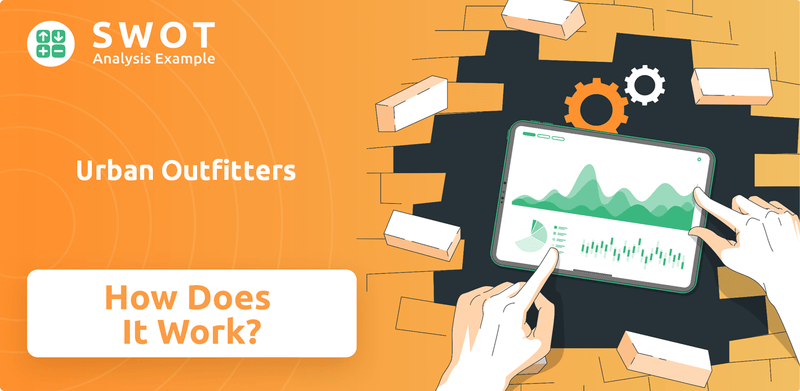
Delving into the Urban Outfitters SWOT Analysis is a crucial first step in understanding the company's operations. This analysis reveals the strengths, weaknesses, opportunities, and threats shaping the Urban Outfitters business model. By examining its multi-channel approach and brand positioning, we can uncover how Urban Outfitters navigates the competitive retail industry and adapts to evolving consumer preferences, ensuring its continued relevance in the apparel market.
What Are the Key Operations Driving Urban Outfitters’s Success?
The core of the Urban Outfitters business model revolves around curating a unique assortment of fashion, home décor, and lifestyle products. This approach allows the company to target specific customer segments through its various brands. The primary focus is on providing on-trend apparel, accessories, and distinctive home goods, primarily catering to young adults through its Urban Outfitters brand, and a more sophisticated aesthetic through Anthropologie and Free People.
Operational processes involve a sophisticated global sourcing and supply chain network. This network allows the company to bring a diverse range of products from various manufacturers to its customers. The processes include design, procurement, logistics, and inventory management. The company's sales channels are multifaceted, encompassing a significant number of retail stores globally, robust e-commerce platforms for each brand, and direct-to-consumer catalogs.
Customer service is integrated across all channels to ensure a seamless shopping experience. A key differentiator lies in the curated nature of its product offerings and the unique store environments, which are designed to reflect the aesthetic of each brand and foster a strong connection with its target demographic. This focus on distinct brand identities and experiential retail, combined with efficient supply chain management and multi-channel distribution, allows Urban Outfitters to maintain a strong market presence and customer loyalty.
Urban Outfitters offers a diverse range of products. The offerings include apparel, accessories, home goods, and lifestyle products. These products are tailored to appeal to young adults. The company's brands, such as Anthropologie and Free People, cater to different aesthetics.
The company utilizes a global sourcing and supply chain network. This network manages design, procurement, logistics, and inventory. Efficient management ensures a diverse range of products. The company focuses on efficient supply chain management and multi-channel distribution.
Sales channels include retail stores, e-commerce platforms, and direct-to-consumer catalogs. Retail stores are located globally. E-commerce platforms are robust for each brand. Customer service is integrated across all channels.
The company focuses on curated product offerings and unique store environments. Store environments reflect each brand's aesthetic. This approach fosters a strong connection with its target demographic. The company aims to create a seamless shopping experience.
Urban Outfitters distinguishes itself through its curated product selections and unique brand environments. This approach helps foster strong customer loyalty and brand recognition within the retail industry. The company's ability to adapt to fashion trends and maintain a strong online presence is crucial. For more information on the target audience, you can read about the Target Market of Urban Outfitters.
- Brand Identity: Strong focus on distinct brand identities (Urban Outfitters, Anthropologie, Free People).
- Experiential Retail: Unique store environments designed to reflect each brand's aesthetic.
- Multi-Channel Distribution: Efficient supply chain management and multi-channel distribution.
- Customer Loyalty: Focus on customer experience to build and maintain loyalty.
Urban Outfitters SWOT Analysis
- Complete SWOT Breakdown
- Fully Customizable
- Editable in Excel & Word
- Professional Formatting
- Investor-Ready Format
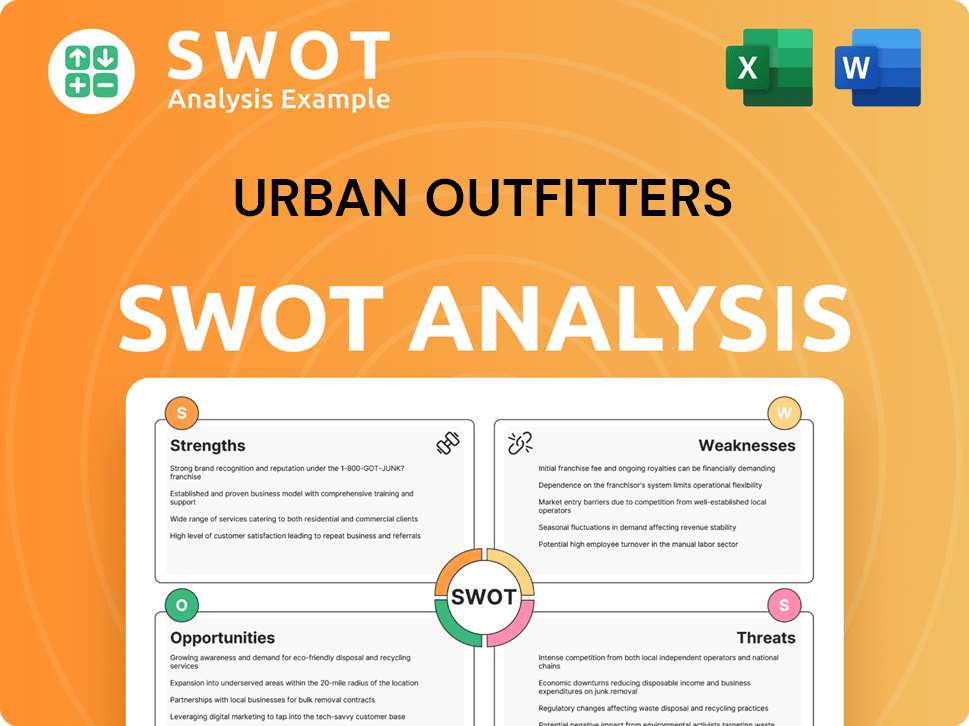
How Does Urban Outfitters Make Money?
The primary revenue stream for the company comes from direct product sales across its various brands. These sales are generated through retail stores, e-commerce websites, and catalog operations. The company's business model is heavily reliant on merchandise sales, which constitute the majority of its total revenue.
For the fiscal year ending January 31, 2024, the company's net sales reached $5.25 billion, reflecting a 1.6% increase. This growth was distributed across its brands, with Urban Outfitters increasing by 2.2%, Anthropologie Group by 3.4%, and Free People Group showing a significant rise of 12.7%.
The company employs standard retail pricing models and utilizes promotional activities and loyalty programs to drive sales and customer engagement. Its monetization strategies also include exclusive collaborations and limited-edition items, which can generate higher margins. The expansion of digital channels, particularly e-commerce, is a key focus for optimizing online sales.
The company leverages several strategies to generate revenue and maintain profitability within the retail industry and apparel market. These strategies are crucial for navigating current fashion trends and consumer preferences.
- Retail Pricing and Promotions: The company uses standard retail pricing combined with promotional activities to encourage sales.
- Loyalty Programs: Customer loyalty programs are implemented to foster repeat purchases and enhance customer engagement.
- Exclusive Collaborations: The company capitalizes on its brand recognition by offering exclusive collaborations and limited-edition items.
- E-commerce Expansion: A strong emphasis is placed on expanding digital channels, especially e-commerce, to optimize online sales.
Urban Outfitters PESTLE Analysis
- Covers All 6 PESTLE Categories
- No Research Needed – Save Hours of Work
- Built by Experts, Trusted by Consultants
- Instant Download, Ready to Use
- 100% Editable, Fully Customizable
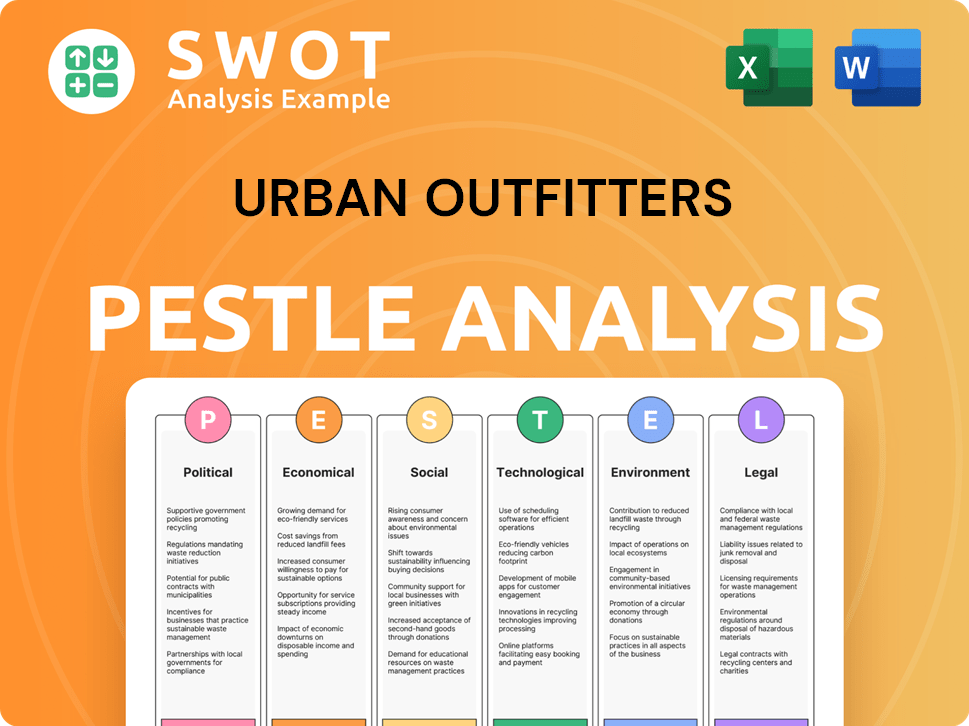
Which Strategic Decisions Have Shaped Urban Outfitters’s Business Model?
The evolution of the [Company Name] has been marked by significant milestones and strategic shifts. A key aspect of its growth has been the successful introduction and development of various lifestyle brands, broadening its customer base and market reach beyond the initial core brand. The company has consistently invested in expanding its retail presence, both domestically and internationally, alongside a robust build-out of its e-commerce capabilities.
Strategic partnerships with designers and artists have played a crucial role in maintaining brand relevance and offering unique product assortments. Navigating operational and market challenges, including shifts in consumer preferences and the broader retail industry's transition towards e-commerce, has been a continuous process. This has involved adapting its product mix, enhancing its digital presence, and optimizing its supply chain for greater efficiency.
The company's competitive advantages include strong brand recognition and loyalty across its portfolio, a highly curated product offering that resonates with its target demographics, and a multi-channel retail strategy that integrates physical and digital experiences. The company continues to adapt to new trends by focusing on experiential retail, personalized online shopping, and incorporating sustainable practices into its operations, aiming to sustain its business model against evolving competitive threats and technological shifts. For a broader perspective, you can explore the Competitors Landscape of Urban Outfitters.
The company has celebrated significant milestones, including the expansion of its brand portfolio with Anthropologie and Free People. This diversification allowed it to capture a wider audience within the apparel market. The company has also seen substantial growth in its e-commerce sector, adapting to the changing demands of the retail industry.
Strategic moves have included investments in digital platforms and supply chain optimization. These moves have been crucial for staying competitive in the evolving fashion trends. The company has also focused on experiential retail to enhance customer engagement, including store renovations and pop-up shops.
The company's competitive edge lies in its strong brand recognition and curated product offerings, appealing to specific customer demographics. Its multi-channel retail strategy integrates physical and digital experiences. The company's ability to adapt to new trends, such as sustainability and personalized shopping, further strengthens its position.
In fiscal year 2024, the company reported net sales of approximately $4.9 billion. The company's gross profit margin was around 32.8%. The company's digital channel sales accounted for a significant portion of its total revenue, demonstrating the success of its e-commerce initiatives.
The company has consistently adapted to the changing dynamics of the retail industry, focusing on innovation and customer experience. This includes enhancing its digital presence and optimizing its supply chain for greater efficiency. The company has also emphasized sustainability practices, incorporating eco-friendly materials and ethical sourcing.
- Enhancing e-commerce capabilities to meet online shopping demands.
- Optimizing the supply chain for greater efficiency and cost-effectiveness.
- Focusing on sustainability by using eco-friendly materials and ethical sourcing.
- Investing in experiential retail to enhance customer engagement.
Urban Outfitters Business Model Canvas
- Complete 9-Block Business Model Canvas
- Effortlessly Communicate Your Business Strategy
- Investor-Ready BMC Format
- 100% Editable and Customizable
- Clear and Structured Layout
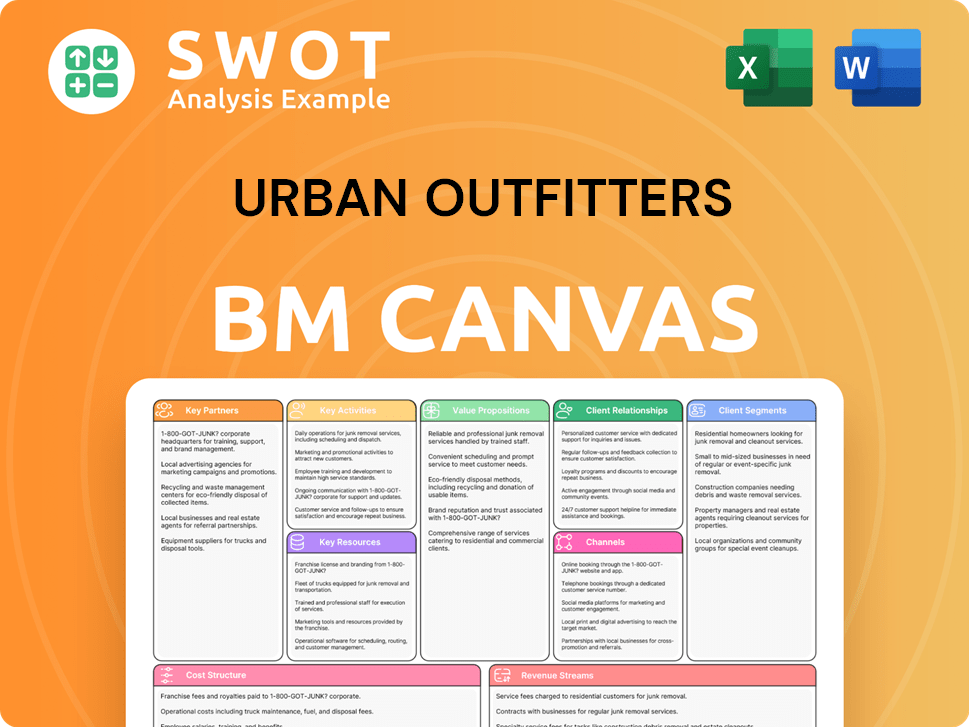
How Is Urban Outfitters Positioning Itself for Continued Success?
The Urban Outfitters company operates within the dynamic lifestyle retail industry. Its multi-brand approach allows it to cater to diverse consumer preferences, solidifying its market position. The Urban Outfitters business model focuses on curating unique product offerings across its brands. For the fiscal year ended January 31, 2024, the company reported net sales of approximately $5.25 billion, demonstrating its substantial presence in the apparel market and beyond.
However, the Urban Outfitters faces several challenges. The retail industry is highly competitive, and fashion trends evolve rapidly. Economic downturns and supply chain issues can also impact the company. To stay ahead, continuous investment in digital platforms and effective inventory management are crucial. For insights into their strategic direction, consider reading about the Growth Strategy of Urban Outfitters.
The company competes with a wide range of retailers in the retail industry, including fast fashion and specialty stores. Its diverse brand portfolio targets various customer segments, contributing to a broad market reach. This multi-brand strategy enables it to capture a significant share of the apparel market.
Key risks include intense competition, shifts in fashion trends, and potential supply chain disruptions. Economic fluctuations can also affect consumer spending and the company's financial performance. The company must adapt to the increasing importance of e-commerce to maintain its competitive edge.
The company is focused on digital platform enhancements and optimizing its store network. Expanding product categories, especially in home goods and wellness, is a key strategy. Operational efficiencies and effective inventory management are also priorities to drive future growth. The focus remains on adapting to evolving consumer demands.
Strategic initiatives include boosting online customer experience and optimizing store locations. The company is expanding its product lines, particularly in home goods and wellness. Improving operational efficiency and managing inventory effectively are also key priorities for future growth.
The company's financial performance is indicative of its market position and strategic execution. Management's focus on digital investments and brand diversification aims to enhance profitability. The emphasis on operational efficiency and inventory management demonstrates a commitment to sustainable growth.
- Continued investment in digital platforms to improve the online customer experience.
- Optimization of the store fleet, including strategic location decisions and store layouts.
- Expansion of product categories, with a focus on home goods and wellness products.
- Enhancing operational efficiencies and effectively managing inventory levels.
Urban Outfitters Porter's Five Forces Analysis
- Covers All 5 Competitive Forces in Detail
- Structured for Consultants, Students, and Founders
- 100% Editable in Microsoft Word & Excel
- Instant Digital Download – Use Immediately
- Compatible with Mac & PC – Fully Unlocked
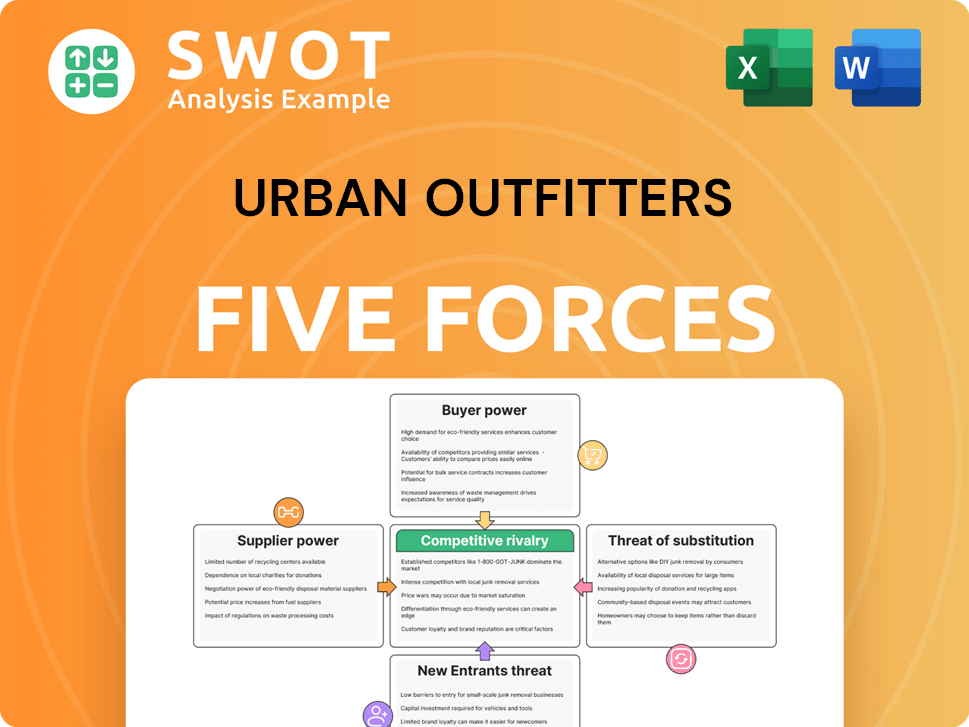
Related Blogs
- What are Mission Vision & Core Values of Urban Outfitters Company?
- What is Competitive Landscape of Urban Outfitters Company?
- What is Growth Strategy and Future Prospects of Urban Outfitters Company?
- What is Sales and Marketing Strategy of Urban Outfitters Company?
- What is Brief History of Urban Outfitters Company?
- Who Owns Urban Outfitters Company?
- What is Customer Demographics and Target Market of Urban Outfitters Company?
Disclaimer
All information, articles, and product details provided on this website are for general informational and educational purposes only. We do not claim any ownership over, nor do we intend to infringe upon, any trademarks, copyrights, logos, brand names, or other intellectual property mentioned or depicted on this site. Such intellectual property remains the property of its respective owners, and any references here are made solely for identification or informational purposes, without implying any affiliation, endorsement, or partnership.
We make no representations or warranties, express or implied, regarding the accuracy, completeness, or suitability of any content or products presented. Nothing on this website should be construed as legal, tax, investment, financial, medical, or other professional advice. In addition, no part of this site—including articles or product references—constitutes a solicitation, recommendation, endorsement, advertisement, or offer to buy or sell any securities, franchises, or other financial instruments, particularly in jurisdictions where such activity would be unlawful.
All content is of a general nature and may not address the specific circumstances of any individual or entity. It is not a substitute for professional advice or services. Any actions you take based on the information provided here are strictly at your own risk. You accept full responsibility for any decisions or outcomes arising from your use of this website and agree to release us from any liability in connection with your use of, or reliance upon, the content or products found herein.